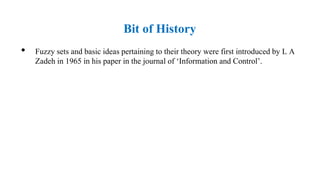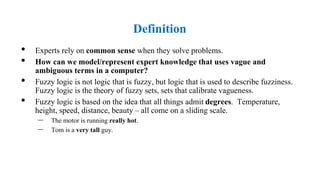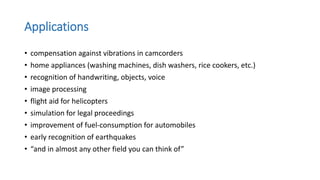Lecture 11 Neural network and fuzzy system
- 1. NEURAL NETWORKS & FUZZY SYSTEMS Course Code: KEE-056 Mr. Mukesh Kumar Singh AP, EED I. E. T. Lucknow Institute of Engineering and Technology (IET) Lucknow Lecture -11 Basic concepts of fuzzy logic, Fuzzy sets
- 2. Detailed syllabus (1) Unit-II: Neural Networks-II (Back propagation networks): Architecture: perceptron model, solution, single layer artificial neural network, multilayer perception model; back propagation learning methods, effect of learning rule co-efficient; back propagation algorithm, factors affecting back propagation training, applications. Unit-I: Neural Networks-1 (Introduction & Architecture) Neuron, Nerve structure and synapse, Artificial Neuron and its model, activation functions, Neural network architecture: single layer and multilayer feed forward networks, recurrent networks. Various learning techniques; perception and convergence rule, Auto-associative and hetro-associative memory
- 3. Detailed syllabus (2) Unit-IV: Fuzzy Logic –II (Fuzzy Membership, Rules): Membership functions, interference in fuzzy logic, fuzzy if-then rules, Fuzzy implications and Fuzzy algorithms, Fuzzyfications & Defuzzificataions, Fuzzy Controller, Industrial applications. Unit-V: Fuzzy Neural Networks: L-R Type fuzzy numbers, fuzzy neutron, fuzzy back propagation (BP), architecture, learning in fuzzy BP, inference by fuzzy BP, applications. Unit-III: Fuzzy Logic-I (Introduction): Basic concepts of fuzzy logic, Fuzzy sets, and Crisp sets, Fuzzy set theory and operations, Properties of fuzzy sets, Fuzzy and Crisp relations, Fuzzy to Crisp conversion.
- 4. Bit of History • Fuzzy sets and basic ideas pertaining to their theory were first introduced by L A Zadeh in 1965 in his paper in the journal of ‘Information and Control’.
- 5. Development Phases • Academic Phase (1965-77) -development of basic ideas of fuzzy set theory -speculation about prospective applications -small no of publications • Transformation Phase (1978-1988) -significant advances in theory -initial evidences of successful industrial applications -increased no. of publications • Fuzzy Boom (since 1989) -rapid increase in successful industrial applications -major companies endorsed the theory and setup R&D centres - computer software and hardware supporting applications of fuzzy logic became commercially available
- 6. Fuzzy Logic • This is the business of having “degrees” of membership rather than “in or out” • Truth values are between true and false • Introduced in 1965 to model uncertainty in natural language: tall, fair, nice, large, hot
- 7. Definition • Experts rely on common sense when they solve problems. • How can we model/represent expert knowledge that uses vague and ambiguous terms in a computer? • Fuzzy logic is not logic that is fuzzy, but logic that is used to describe fuzziness. Fuzzy logic is the theory of fuzzy sets, sets that calibrate vagueness. • Fuzzy logic is based on the idea that all things admit degrees. Temperature, height, speed, distance, beauty – all come on a sliding scale. – The motor is running really hot. – Tom is a very tall guy.
- 8. Definition • Since knowledge can be expressed in a more natural way by using fuzzy sets, many engineering and decision problems can be greatly simplified. • Boolean logic uses sharp distinctions. It forces us to draw lines between members of a class and non-members. For instance, we may say, Tom is tall because his height is 181 cm. If we drew a line at 180 cm, we would find that David, who is 179 cm, is small. • Is David really a small man or we have just drawn an arbitrary line in the sand?
- 9. When is to Use Fuzzy Logic ? • One or more of the control variables are continuous • Mathematical model of process does not exist • Difficult to encode even if exists • Model too complex to be evaluated fast enough for real time operation • Involves too much memory on designated chip arch. • While important to use inexpensive sensors and/or low precision micro-controller • High ambient noise level to deal with • Above all, an expert is available who can specify the rules underlying system behaviour
- 10. Fuzzy Logic PROS: • Used to solve highly complex problems where mathematical modeling is too difficult/impossible • Tolerant of imprecise data • Universal approximation: can model arbitrary nonlinear functions • Intuitive • Based on linguistic terms • Convenient way to express expert and common sense knowledge
- 11. Fuzzy Logic Cons: • Not a cure for all • Crisp/precise models can be more efficient and even convenient • Other approaches might be required to verify the work
- 12. The basic idea of the fuzzy set theory is that an element belongs to a fuzzy set with a certain degree of membership. A fuzzy set is a set with fuzzy boundaries A proposition is neither true nor false (fuzzy logic), but may be partly true (or partly false) to any degree. This degree is usually taken as a real number in the interval [0,1] Fuzzy logic is an extension of classic two-valued logic – the truth value of a sentence is not restricted to true or false Fuzzy Set Theory
- 13. The classical example in fuzzy sets is tall men. The elements of the fuzzy set “tall men” are all men, but their degrees of membership depend on their height tall men fuzzy Set Degree of Membership Fuzzy Mark John Tom Bob Bill 1 1 1 0 0 1.00 1.00 0.98 0.82 0.78 Peter Steven Mike David Chris Crisp 1 0 0 0 0 0.24 0.15 0.06 0.01 0.00 Name Height, cm 205 198 181 167 155 152 158 172 179 208 Fuzzy Sets
- 14. The x-axis represents the universe of discourse the range of all possible values applicable to a chosen variable. In our case, the variable is the man height. According to this representation, the universe of men’s heights consists of all men. The y-axis represents the membership value of the fuzzy set. In our case, the fuzzy set of tall men maps height values into corresponding membership values. Fuzzy Sets
- 15. A fuzzy set is a set with fuzzy boundaries. Let X be the universe of discourse and its elements be denoted as x. In the classical set theory, crisp set A of X is defined as function fA(x) called the characteristic function of A fA(x) = {0, 1}, x X where A x A x x fA if 0, if 1, ) ( Fuzzy Sets
- 16. In the fuzzy theory, fuzzy set A of universe X is defined by function A(x) called the membership function of set A A(x): X [0, 1], where A(x) = 1 if x is totally in A; A(x) = 0 if x is not in A; 0 < A(x) < 1 if x is partly in A. For any element x of universe X, membership function A(x) equals the degree to which x is an element of set A. This degree, a value between 0 and 1, represents the degree of membership of element x in set A. Fuzzy Sets
- 17. Fuzzy Sets •Sets with fuzzy boundaries A = Set of tall people Heights 180cm 1.0 Crisp set A Membership function Heights 170 178cm .5 .9 Fuzzy set A 1.0
- 18. Fuzzy Sets with Discrete Universes • Fuzzy set C = “desirable city to live in” X = {Chd, Delhi, Mumbai} (discrete and non-ordered) C = {(Chd, 0.9), (Delhi, 0.8), (Mumbai, 0.6)} • Fuzzy set A = “sensible number of children” X = {0, 1, 2, 3, 4, 5, 6} (discrete universe) A = {(0, .1), (1, .3), (2, .7), (3, 1), (4, .6), (5, .2), (6, .1)}
- 19. Fuzzy Sets with Cont. Universes • Fuzzy set B = “about 50 years old” X = Set of positive real numbers (continuous) B = {(x, B(x)) | x in X} B x x ( ) 1 1 50 10 2
- 20. • More crisp and fuzzy sets defined on the universe 150 210 170 180 190 200 160 Height, cm Degree of Membership Tall Men 150 210 180 190 200 1.0 0.0 0.2 0.4 0.6 0.8 160 Degree of Membership Short Average Short Tall 170 1.0 0.0 0.2 0.4 0.6 0.8 Fuzzy Sets Crisp Sets Short Average Tall Tall Fuzzy Sets
- 21. Fuzzy Sets • Formal definition: A fuzzy set A in X is expressed as a set of ordered pairs: A x x x X A {( , ( ))| } Universe or universe of discourse Fuzzy set Membership function (MF) A fuzzy set is totally characterized by a membership function (MF).
- 22. Fuzzy Subset A Fuzziness 1 0 Crisp Subset A Fuzziness x X (x) Typical functions that can be used to represent a fuzzy set are sigmoid, gaussian and pi. However, these functions increase the time of computation. Therefore, in practice, most applications Represent fuzzy subsets by linear fit functions. Fuzzy Sets
- 23. Conceptualising in fuzzy terms • Standard membership functions: • single-valued, or singleton • triangular • trapezoidal • S-function (sigmoid function): • S(u) = 0, u<=a • S(u) = 2((u-a)/(c-a))2 , a <u <= b • S(u) = 1 - 2((u-a)/(c -a))2 , b <u <= c • S(u) = 1, u > c.
- 24. Conceptualizing in fuzzy terms... • More standard membership functions... • Z function: • Z(u)= 1 - S(u) • Pi - function: • P(u)=S(u), u<=b; P(u)=Z(u), u>b. • Two parameters must be defined for the quantization procedure: • the number of the fuzzy labels; • the form of the membership functions for each of the fuzzy labels.
- 25. Conceptualizing in fuzzy terms... Standard types of membership functions: Z function; S function; trapezoidal function; triangular function; singleton.
- 26. Applications • compensation against vibrations in camcorders • home appliances (washing machines, dish washers, rice cookers, etc.) • recognition of handwriting, objects, voice • image processing • flight aid for helicopters • simulation for legal proceedings • improvement of fuel-consumption for automobiles • early recognition of earthquakes • “and in almost any other field you can think of”
- 27. Limitations of Fuzzy Logic • Stability: since fuzzy logic is not formal, there is no guarantee that a fuzzy system will function correctly • Learning: no ability to learn membership functions and no memory to learn during problem solving • Determining good membership functions and fuzzy rules is not always easy or straightforward • Verification and Validation requires extensive testing (as in any expert system). This is especially important of controllers where safety becomes a key factor (e.g. subway system, space shuttle)
- 28. References • Timothy Ross,”Fuzzy Logic with Engineering Applications” Published by Mc Graw Hill • H. A Toliyat, M.S. Arefeen,”Introduction to Fuzzy Logic” • B K Bose,”Fuzzy Logic and Neural Network Applications” • Ahmad M Ibrahim, “Applied Fuzzy Logic Controllers” Published by PHI • Johon Yeri, Raza Langari, “ Fuzzy Logic Intelligence Control and Information” Published by Pearson Education Pvt. Limited • George J. Klir and Bo Yuan, “Fuzzy Sets and Fuzzy Logic Theory and Applications”, Published by PHI
- 29. Fuzzy Logic : An Idea
- 30. Why? • Why fuzzy? As Zadeh said, the term is concrete, immediate and descriptive; we all know what it means. However, many people in the West were repelled by the word fuzzy, because it is usually used in a negative sense. • Why logic? Fuzziness rests on fuzzy set theory, and fuzzy logic is just a small part of that theory.
- 31. The Term “Fuzzy Logic” • The term fuzzy logic is used in two senses: • Narrow sense: Fuzzy logic is a branch of fuzzy set theory, which deals (as logical systems do) with the representation and inference from knowledge. Fuzzy logic, unlike other logical systems, deals with imprecise or uncertain knowledge. In this narrow, and perhaps correct sense, fuzzy logic is just one of the branches of fuzzy set theory. • Broad Sense: fuzzy logic synonymously with fuzzy set theory











![ The basic idea of the fuzzy set theory is that an element
belongs to a fuzzy set with a certain degree of membership.
A fuzzy set is a set with fuzzy boundaries
A proposition is neither true nor false (fuzzy logic), but may
be partly true (or partly false) to any degree. This degree is
usually taken as a real number in the interval [0,1]
Fuzzy logic is an extension of classic two-valued logic – the truth
value of a sentence is not restricted to true or false
Fuzzy Set Theory](https://image.slidesharecdn.com/lecture11nnfs-240727120335-da49fa56/85/Lecture-11-Neural-network-and-fuzzy-system-12-320.jpg)



![ In the fuzzy theory, fuzzy set A of universe X is
defined by function A(x) called the
membership function of set A
A(x): X [0, 1],
where A(x) = 1 if x is totally in A;
A(x) = 0 if x is not in A;
0 < A(x) < 1 if x is partly in A.
For any element x of universe X, membership
function A(x) equals the degree to which x is
an element of set A. This degree, a value
between 0 and 1, represents the degree of
membership of element x in set A.
Fuzzy Sets](https://image.slidesharecdn.com/lecture11nnfs-240727120335-da49fa56/85/Lecture-11-Neural-network-and-fuzzy-system-16-320.jpg)














